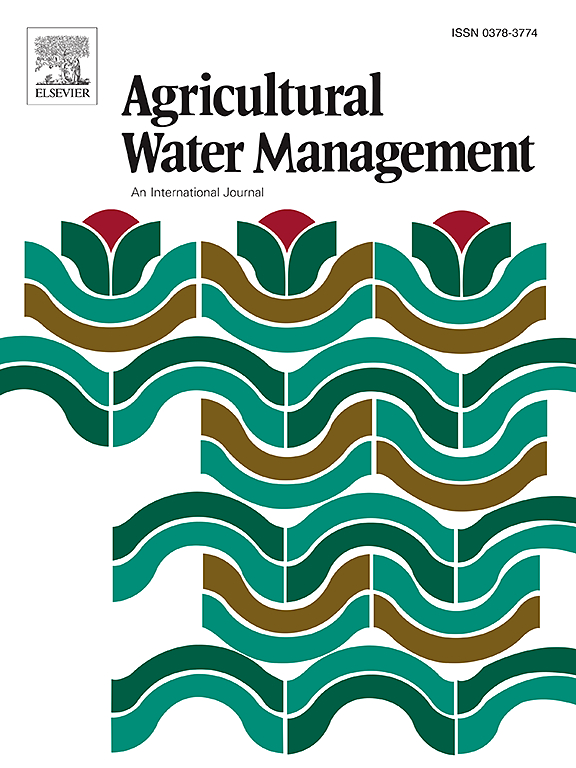保护性耕作下小麦产量、水分生产力、水足迹和经济效益的权衡:一项长期田间试验方法
IF 6.5
1区 农林科学
Q1 AGRONOMY
引用次数: 0
摘要
水足迹(WF)是一个水资源可持续管理指标,它量化了作物生产中的虚拟用水量。研究了中国半干旱黄土高原地区小麦(Triticumaestivum L.)在不同耕作方式下的水分生产率(WP)和水足迹。2002-2017年期间,小麦采用了六种耕作方式:常规耕作(T)、无秸秆覆盖免耕(NT)、秸秆覆盖常规耕作(TS)、秸秆覆盖免耕(NTS)、塑料覆盖常规耕作(TP)、塑料覆盖免耕(NTP)。耕作方法并没有明显增加作物的蒸散量,但 NTS、TP 和 NTP 在减少土壤蒸散量的同时增加了蒸腾、根系生长和生物量积累。此外,NTS 降低了早期阶段的耗水量,但提高了从抽穗到收获期的水分利用率,而 TP 和 NTP 则表现出相反的模式。在 TS、NTS、TP 和 NTP 条件下,小麦产量分别比 T 条件下高出 13%、28%、22% 和 24%,相应的水分生产率分别提高了 15%、24%、26% 和 24%。与 T 相比,NT、TS、NTS、TP 和 NTP 的净经济收益变化分别为 39%、21%、148%、-49% 和 18%;可持续性产量指数分别为 0.45、0.41、0.52、0.55、0.48 和 0.47。与T相比,TS和NTS的总耗水量分别大幅增加了8.2%和9.8%;与T相比,NTS、TP和NTP的WF分别大幅减少了18.6%、18.5%和22.3%。这些结果表明,在灌浆期,NTS 通过促进根系生长和水分利用,在减少 WF 的情况下提高了产量、经济效益和 WP。因此,NTS 是半干旱黄土高原地区小麦的一种可持续水资源管理策略。本文章由计算机程序翻译,如有差异,请以英文原文为准。
Trade-offs among yield, water productivity, water footprint, and economic benefits for wheat production under conservation tillage: A long-term field experiment approach
Water footprint (WF) is a water sustainable management indicator that quantifies the virtual water use in crop production. Water productivity (WP) and WF were examined under different tillage practices for wheat (Triticumaestivum L.) in the semiarid Loess Plateau of China. Wheat was grown in 2002 −2017 with six tillage practices: conventional tillage (T), no-till without straw cover (NT), conventional tillage with straw cover (TS), no-till with straw cover (NTS), conventional tillage with plastic mulching (TP), no-till with plastic mulching (NTP). Tillage practices did not significantly increase crop evapotranspiration, but NTS, TP, and NTP reduced soil evaporationwhile increasing transpiration, root growth and biomass accumulation. Additionally, NTS reduced the water consumption during the early stage but increased the water utilization from heading to harvest, while TP, and NTP exhibited the opposite pattern. Wheat yield under TS, NTS, TP, and NTP was higher by13, 28, 22, and 24 %, respectively, than under T, with corresponding improvements in water productivity of 15, 24, 26, and 24 %, respectively. The change in net economic return was 39, 21, 148, −49, and 18 % for NT, TS, NTS, TP, and NTP, respectively, compared to T; the sustainability yield index was 0.45, 0.41, 0.52, 0.55, 0.48 and 0.47, respectively. Total water consumption was significantly increased by 8.2 and 9.8 % under TS and NTS, respectively, compared to T. WF under NTS, TP and NTP was significantly decreased by 18.6, 18.5 and 22.3 % compared to T, respectively. These results suggests that NTS increased yield, economic benefits and WP with less WF through enhancing root growth and water utilization during the filling period. Therefore, NTS represented a sustainable a sustainable water management strategy for wheat in the semiarid Loess Plateau.
求助全文
通过发布文献求助,成功后即可免费获取论文全文。
去求助
来源期刊

Agricultural Water Management
农林科学-农艺学
CiteScore
12.10
自引率
14.90%
发文量
648
审稿时长
4.9 months
期刊介绍:
Agricultural Water Management publishes papers of international significance relating to the science, economics, and policy of agricultural water management. In all cases, manuscripts must address implications and provide insight regarding agricultural water management.
 求助内容:
求助内容: 应助结果提醒方式:
应助结果提醒方式:


